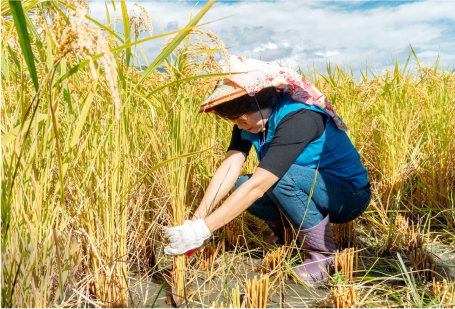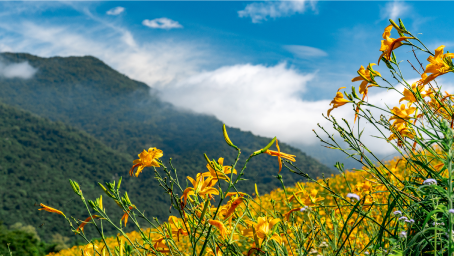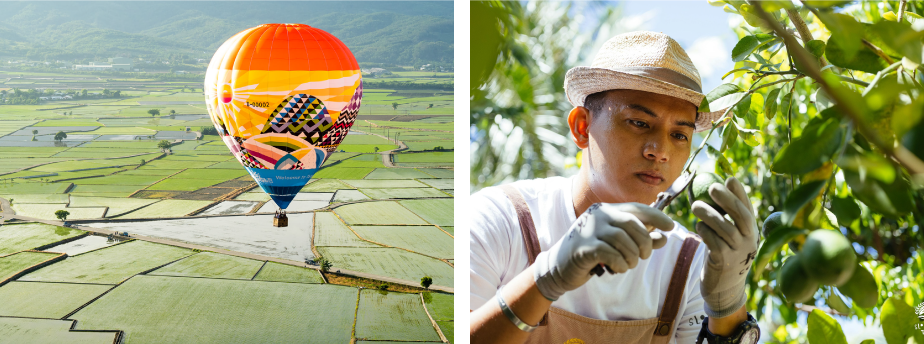 |
| Plains of Production |
|
This year, we aim to present Taitung to the reader using a new, geo-thematic approach. We will explore the interplay between Taitung’s unique geographical features, environment and climate on the one hand, and the culture, economy and lifestyle of its inhabitants on the other. In doing so, we hope to impress upon the reader a deepened appreciation and heightened curiosity for our county. This first issue of Taitung Times in 2024 will deal with Taitung’s plains, and then we will successively cover forests, rivers, islands and coasts, before finishing the year with a special edition dedicated to “spatial sacrality” in the county. CIVILIZATION CRADLE
It is no wonder that of all the natural habitats present on this planet, it was plains that have arguably had the greatest impact upon human evolution. As centers of agricultural production, plains facilitated the growth of the first civilizations and continue to be home to the largest urban areas on Earth today. TAITUNG’S PLAINS
While Taitung’s lofty mountains and azure coastline might appear at first glance to be the most prominent features of the county, the plains of Taitung actually play a much larger role in the local economy. As a quick overview of a topographical map of the region would suggest, the amount of land that can be confidently classified as being a plain in Taitung is essentially restricted to the bottom half of the East Rift Valley southwards from Chishang and the roughly 100 square kilometer “triangle” that connects Zhiben, the mouth of the Beinan River just north of Taitung City, and Chulu. Some smaller strips of arable land appear along the coastline, most notably around Taimali in the south as well as Chenggong and Changbin up north. It is rather surprising, then, to consider that agriculture is the main staple of Taitung’s economy, given this apparent scarcity of flatlands. This preponderance of the primary sector hints is a testament to the extreme fertility of Taitung’s soil, which is caused by several factors. Firstly, Taitung County's advantageous geography makes it ideal for agriculture. Nestled between the Central Mountain Range to the West and the Coastal Mountain Range to the East, and at about two hundred meters of altitude, the East Rift Valley's temperature fluctuations spur robust crop growth, resulting in higher quality produce compared to the western plains. The mineral-rich volcanic soil, ample rainfall, and mild climate create a nurturing environment for diverse and high quality crops year-round. Firstly, Taitung County's advantageous geography makes it ideal for agriculture. Nestled between the Central Mountain Range to the West and the Coastal Mountain Range to the East, and at about two hundred meters of altitude, the East Rift Valley's temperature fluctuations spur robust crop growth, resulting in higher quality produce compared to the western plains. The mineral-rich volcanic soil, ample rainfall, and mild climate create a nurturing environment for diverse and high quality crops year-round. Most famous is the atemoya, a hybrid of the sugar apple and cherimoya. Around 2,800 hectares produce 20,000 tons annually, generating $100 million USD in revenue. Again, geography is the secret behind Taitung’s reputation as an “atemoya Mecca”: being located on the East coast means the county’s coastal plains are exposed to the Kuroshio Current. The Kuroshio endows the region with warm and dry winters, which, coupled with sandy ground and its excellent drainage qualities, provide the perfect conditions not only for atemoya but also a whole range of produce such as mangoes, bananas, papayas, guavas, jackfruit, and citrus fruits. As for staple crops, rice and millet have the longest history, with traces found at the Beinan site dating from about 3000 BC. THE HUMAN DIMENSION
 The fertile Taitung plains alone could not have yielded such bountiful agriculture without ingenious farmers who learned to cooperate with nature. On the modest tracts of arable land, generations of producers observed natural patterns and devised optimal cultivation methods. Their focus shifted from maximizing yields to enhancing quality, demonstrating respect for the environment. Techniques like crop rotation, green manure cover crops, and rapeseed planting improve soil nutrition in sustainable ways. "Friendly farming" incorporates intercropping, reduced chemical usage, and preservation of wildlife habitats. Hard-won wisdom passed down over centuries helps today's Taitung farmers practice responsible stewardship of the land. INDIGENOUS PLAIN DWELLERS
 Taitung is home to seven indigenous groups, which themselves are divided into many Buluo, or “tribal villages”. The triangular plain around Taitung is home mostly to the Pinuyumayan (previously known as the Beinan) people, with the Rukai inhabiting the surrounding foothills. The East Rift Valley is shared notably by the Bunun and the Amis, Paiwan communities are spread along the South Link, and the Coastline north of Taitung City is mostly settled by the Amis and Kavalan people. The fertile plains of Taitung enabled the traditional indigenous communities to develop rich agricultural lifestyles and rituals. The Pinuyumayan grew foxtail millet, hemp, soybeans and wheat, later adopting wet rice cultivation that brought economic prosperity. They held the Mugamut ritual celebrating the end of the female mowing season. The Kavalan farmed sweet potatoes, taro, rice and upland rice. Foxtail millet was integral to Rukai and Bunun cultures, forming the center of their harvest celebrations. The Rukai saw millet as symbolic of sharing and congratulations. During Qing and Japanese rule, the Amis transitioned from cultivating millet to widespread rice agriculture, shifting their kiluma’an harvest festival date accordingly. The Bunun originally grew millet before the Japanese introduced rice, but still maintained millet rituals. Across the plains, cycles of sowing and harvesting millet, rice and other staples gave rhythm to community life. Harvest rituals, from Bunun prayers for bountiful millet to Pinuyumayan celebrations on mowing's completion, gave thanks for nature's provision. Just like our modern capitalist society, these ancient agricultural societies engaged themselves in a literal “cult of productivity”, but this “cult” was in tune – rather than antagonistic to – nature. In other words, it was a sustainable model of production, which has been carried on to this day. FRESH ARRIVALS
The successive waves of colonization, from the Qing to the Japanese to the Chinese, which swept Taiwan over the last few centuries, brought many new inhabitants to Taitung’s plains, most notably the Han Chinese. The Japanese in particular quickly realized how well suited the fertile plains of Taitung were for rice production. They brought in thousands of Han and Hakka farmers to settle down in Taitung’s plains. Unlike the more hybrid indigenous societies that were as comfortable farming as hunting and fishing, the Han and Hakka were more exclusively agricultural, and traditionally viewed the mountains and the sea with suspicion. The Japanese regime therefore used these populations of farmers to develop more arable land, and simultaneously introduced modern, intensive, large scale agriculture. Indeed, Taitung’s plains owe their irrigation system - complete with canals, embankments and sluice gates - to the Japanese Colonial period. Railways were also built to help export Taitung’s precious produce to the larger cities West and North, and remains of these large civil engineering projects dot the county. Indeed, Taitung’s plains owe their irrigation system - complete with canals, embankments and sluice gates - to the Japanese Colonial period. Railways were also built to help export Taitung’s precious produce to the larger cities West and North, and remains of these large civil engineering projects dot the county. The Japanese colonial period can be credited on the one hand to have laid the basis for Taitung’s current development and agricultural sector. On the other hand, the modern, industrial methods of production that replaced the traditional ones, also brought in some negative side effects. Last century’s relentless pursuit of increased yields and product appearance, encouraged excessive use of pesticides and chemical fertilizers. Farmers rushed harvests, depleting the topsoil of nutrients, which in turn lead to poorer quality produce as well as a damaged ecosystem. On a social level, policies that marginalized indigenous communities, for instance by dispossessing them of their ancestral land or forbidding traditional customs and folklore, increased disparity and thinned the cultural fabric of the region. Inhabitants started to realize that the birds and bugs that populated their childhood memories were becoming an increasingly rare sight; indigenous communities started forgetting the traditions of their ancestors. On a social level, policies that marginalized indigenous communities, for instance by dispossessing them of their ancestral land or forbidding traditional customs and folklore, increased disparity and thinned the cultural fabric of the region. Inhabitants started to realize that the birds and bugs that populated their childhood memories were becoming an increasingly rare sight; indigenous communities started forgetting the traditions of their ancestors. It took decades for farmers and policymakers to realize that Taitung’s plains, due to their relative scarcity, could not compete in terms of total output with those of the west coast. It finally dawned to people that the county’s competitive advantage lay in quality, not quantity, and that what made Taitung unique in Taiwan, was its pristine environment, rich ecosystem, and precious cultural heritage. A NEW HOPE
It was therefore with this unique historical backdrop and challenges in mind that County Magistrate April Yao came up with the “Slow Economy”. The Slow Economy nurtures quality of life, eco-friendly businesses, and meaningful tourist experiences that encourage repeat visits, and taps into Taitung's natural assets to build competitive advantages. Yao’s administration assists farmers, firstly by incentivizing eco-friendly and organic farming, then by promoting a slow food movement and a philosophy of eating local and in season, with its tenets “GOOD”, “CLEAN”, and “FAIR”. The state ensures stable agricultural markets, and connects producers to domestic and international buyers. It also forges partnerships to make Taitung a hub for showcasing Austronesian cultures. By blending the traditional with the modern, and by leveraging rich cultural roots and natural heritage, Taitung charts a unique development path - one that sustains its communities and environment for generations to come. Thanks to the Slow Economy, the fertile plains of Taitung, as well as the people who populate them, can enjoy a prosperous and harmonious future.  Surrounding Taitung’s plains are countless peaks that lush forests cover, like a carpet of giant moss. Sustainable development of the plains must go hand in hand with the protection of these woodlands, which, as we shall see in the next issue of Taitung Times, have acted since time immemorial as a treasure trove for Taitung’s inhabitants. |
| © TAITUNG COUNTY GOVERNMENT 2024 |






